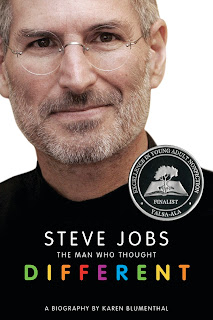In the world of nonfiction for
young people, California librarian Jonathan Hunt is one of my gurus. His
reviews and essays are always incredibly insightful, and his latest article in Horn Book is no exception.
His thoughtful look at readers of
children’s and young adult nonfiction comes on the heels of two recent
experiences, the Texas Library Association annual conference and the upcoming paperback
publication of my book Bootleg: Murder,
Moonshine, and the Lawless Years of Prohibition.
I was at TLA because Bootleg is part of the new Spirit of
Texas Middle School program, which recognizes authors with a Texas connection.
In addition, my book Steve Jobs: The Man
Who Thought Different is on this year’s Lone Star list for
middle-schoolers, and I had a chance to visit with some of the amazing
librarians who devote their precious spare time to reading and picking books
for these lists.
One of them surprised me with her description of her
readers. Her middle school students are “insulted” by heavily illustrated
nonfiction and almost shun them, she told me. Instead, they gravitate to smaller
books like Steve Jobs because it’s
neither too thick nor too thin, and it is sparingly illustrated.
Hunt said almost the same thing in
his essay, noting that “too many photographs can rob author and reader alike of
the opportunity to exercise their imagination.”
.jpg) As an avid nonfiction reader who
would appreciate more photos and relevant images in adult books, I always assumed
illustrations brought a greater depth and visual dimension to a true story. But
they have another side effect: To properly display images, nonfiction children’s
books are somewhat larger than fiction books, which gives them the appearance
of either picture books (babyish!) or coffee table books (and who wants to
actually read those?)
As an avid nonfiction reader who
would appreciate more photos and relevant images in adult books, I always assumed
illustrations brought a greater depth and visual dimension to a true story. But
they have another side effect: To properly display images, nonfiction children’s
books are somewhat larger than fiction books, which gives them the appearance
of either picture books (babyish!) or coffee table books (and who wants to
actually read those?)
In fact, Hunt makes the case for
smaller “novelistic” book sizes for factual stories, saying that they circulate
easily in his library, without any special selling from him.
That’s encouraging news for Bootleg, which is the first of my four
books for young people to go from hardcover to trade paperback. (Steve
Jobs was published simultaneously in hardcover and paperback.)
Lauren Burniac, who oversees the
paperback imprint Square Fish, says the Bootleg
paperback, which will be out in late July, will be smaller in size than the
original, which itself had a smaller trim size than many contemporary
nonfiction books.
 |
| Paperback edition |
“We’re making a real effort to
bring nonfiction into paperback,” she says, with the hope that a lower price
will bring the books not just into libraries, but also into classrooms. (And, I hope, maybe on to home bookshelves!)
Will a paperback nonfiction book in a smaller size attract more buyers and more readers?
Will a paperback nonfiction book in a smaller size attract more buyers and more readers?
Or does that old publishing saw
hold, that people choose fiction for the authors and
nonfiction for the subject?
What do you think?

.jpg)
2 comments:
Interesting, if sigh-inducing insights...if it's true that size and/or number of images can determine whether a book gets read or not, it's certainly something authors and publishers should consider. If a book is in electronic format, the size won't be an issue at least!
Hi, Karen. Welcome to I.N.K. I'm currently working on my first nonfiction book that won't have a lot of photos, and I must say, it's a strange feeling. I thought the Common Core placed a value on the inclusion of photographs and artifacts in nonfiction books. As a former reluctant reader myself, I certainly appreciated information that was presented visually. At any rate, good luck with the Bootleg paperback!
Post a Comment